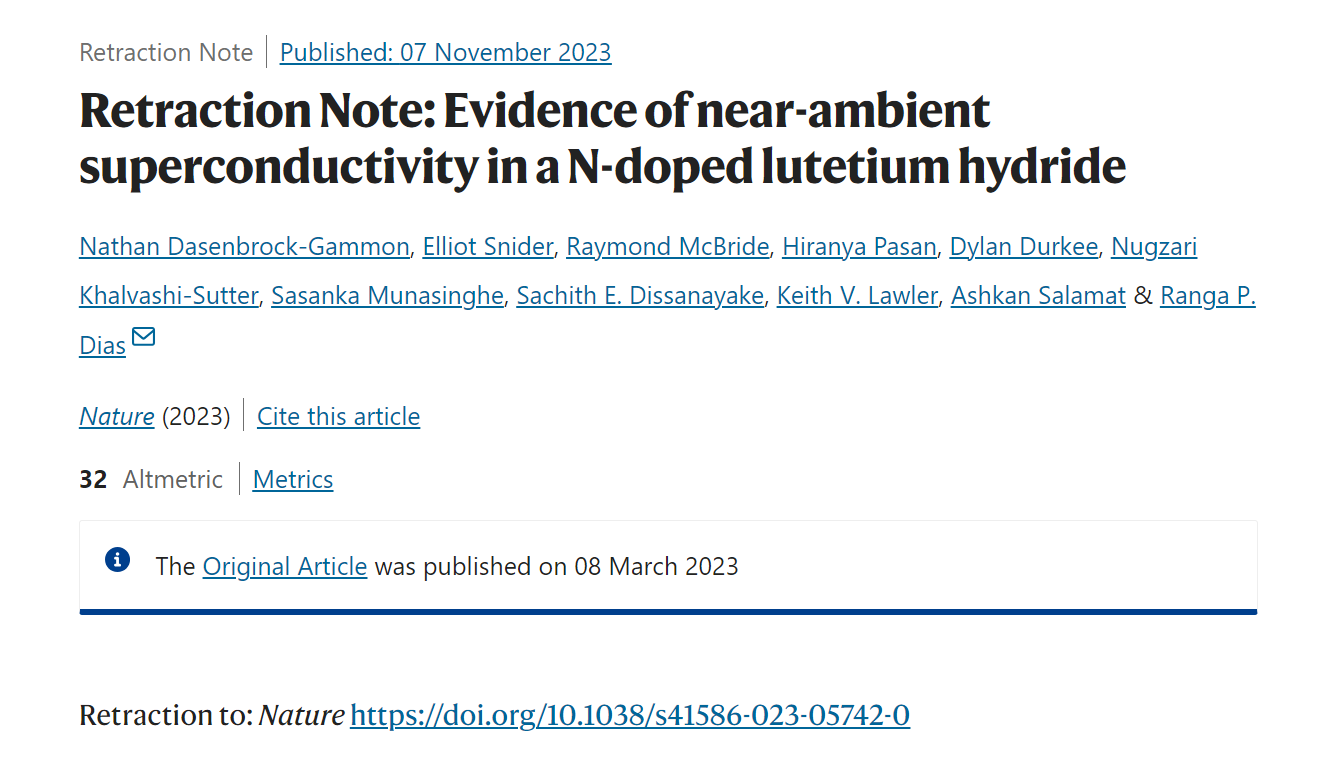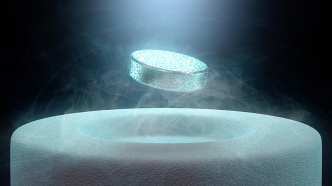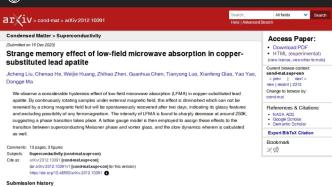

According to the retraction, multiple named authors stated that the published paper did not accurately reflect the sources of the materials studied, the experimental measurements performed and the data processing protocols applied. This undermines the integrity of the published paper.
The US paper on room temperature superconductivity was withdrawn.
The paper in question was previously published online in the international academic journal Nature.
In a related statement received by ThePaper Technology on November 8, Karl Ziemelis, editor-in-chief of applied and physical sciences of the journal Nature, said, “ This situation is deeply frustrating .” “After the paper was published, It is not uncommon for further issues to arise, at which point the paper is subject to greater technical scrutiny by the wider academic community.”
On the 7th, the "Nature" journal website published a retraction statement online stating that because the published paper did not accurately reflect the source of the materials studied, the experimental measurements performed, etc., it was withdrawn from Rochester, USA at the request of multiple signed authors. A research paper with Ranga P. Dias, assistant professor in the University's Department of Mechanical Engineering and Assistant Professor in the Department of Physics and Astronomy, as the corresponding author. However, Dias himself has not responded whether he agrees with the retraction.
It was only 8 months from when it was published online to when it was withdrawn. This is Dias's third paper to be retracted.
The title of the paper involved is "Evidence of near-ambient superconductivity in a N-doped lutetium hydride".
The paper states that they developed a material containing lutetium, hydrogen, and nitrogen that exhibits superconducting properties at room temperature of about 20.6 degrees Celsius and a pressure of 10 kilobar (about 10,000 times atmospheric pressure). The paper was published online on March 8 in the international academic journal Nature.
Subsequently, multiple international research teams claimed that they could not reproduce the results reported in Dias's previous paper.
Just 7 days after the aforementioned paper was published online, Professor Wen Haihu's team from the School of Physics of Nanjing University in China announced relevant experimental results, saying that it overturned the room temperature superconducting research results of Dias and others.
The aforementioned research results of Professor Wen Haihu's team were published online in the journal Nature on May 11: The nitrogen-doped lutetium hydride (also known as lutetium-hydrogen-nitrogen compound) they prepared did not exhibit near-normal behavior. Room temperature superconductivity.

Invented a material that superconducts at room temperature? A paper on room-temperature superconducting materials by Ranga P. Dias, assistant professor in the Department of Mechanical Engineering and Department of Physics and Astronomy at the University of Rochester, USA, as the corresponding author, was withdrawn.
The aforementioned retraction statement of "Nature" stated, "At the request of the authors Nathan Dasenbrock-Gammon, Elliot Snider, Raymond McBride, Hiranya Pasan, Dylan Durkee, Sachith E. Dissanayake, Keith V. Lawler and Ashkan Salamat, this article has been withdrawn. As Researchers who contributed to this work stated that the published paper did not accurately reflect the origin of the materials studied, the experimental measurements performed and the data processing protocols applied. The above-mentioned authors concluded that these issues undermine the integrity of the published paper.”
"In addition, concerns were separately raised with the journal about the reliability of the resistance data presented in the paper. An investigation and post-publication review by the journal concluded that these concerns were credible, substantive, and remain unresolved solve."
"Nugzari Khalvashi-Sutter, Sasanka Munasinghe and Ranga P. Dias have not yet indicated whether they agree with the retraction."
The paper involved stated that if superconducting materials have no resistance under normal temperature and pressure conditions, then it will have huge application potential. Despite decades of diligent research, this state of affairs has yet to be achieved. Under normal pressure conditions, copper oxide is a type of material with superconductivity, and its critical superconducting transition temperature (Tc) can reach up to 133K (minus 140.15 degrees Celsius). Over the past decade, high-pressure "chemical precompression" of hydrogen alloys has led the search for high-temperature superconductivity, with the Tc of binary hydrides at megabar pressures approaching the freezing point of water. Ternary hydrogen-rich compounds, such as carbon-sulfide hydrides, provide greater chemical space and have the potential to improve the properties of superconducting hydrides. In this paper, we report evidence of superconductivity in a nitrogen-doped lutetium hydride with a maximum Tc value of 294 K (20.85 degrees Celsius) at 10 kbar, i.e., superconducting at room temperature and near atmospheric pressure. sex. The compound was synthesized under high-pressure and high-temperature conditions, and after full recovery, its material and superconducting properties were examined along the compression path. However, further experiments and simulations are needed to determine the exact ratio of hydrogen and nitrogen and their respective atomic positions to further understand the material's superconducting state.
However, the paper has now been withdrawn.
A news article published on the official website of the journal "Nature" stated that experimental physicist N. Peter Armitage of Johns Hopkins University in the United States said: "Almost every serious condensed matter researcher I know Physicists immediately saw serious problems with this work." Measurements of the material's electrical resistance, in particular, were called into question.
Armitage added that the publication of the paper in Nature raises questions about Nature's editorial review process, and people are confused as to why the reviewers did not notice these issues.
"(But) the peer review process cannot discover whether a precisely written paper like this reflects the research conducted." Carl Zimmeris, editor-in-chief of applied and physical sciences at the journal Nature, said in a statement.
According to the relevant webpage of the Hajim College of Engineering and Applied Science at the University of Rochester, Dias received a bachelor's degree from the University of Colombo, Sri Lanka , in 2006, and a Ph.D. in physics from Washington State University, the United States, in 2013. Before joining the University of Rochester, he worked as a postdoctoral researcher in the Department of Physics at Harvard University, studying the quantum phenomena of hydrogen under extreme conditions. "Dias is an internationally recognized scientist in the field of high-pressure physics, and his research has been reported in popular media such as The New York Times, BBC, NBC, NPR, Physics Today, New Scientist, Chemistry World, Science News and Nature News & Views, among others.”


